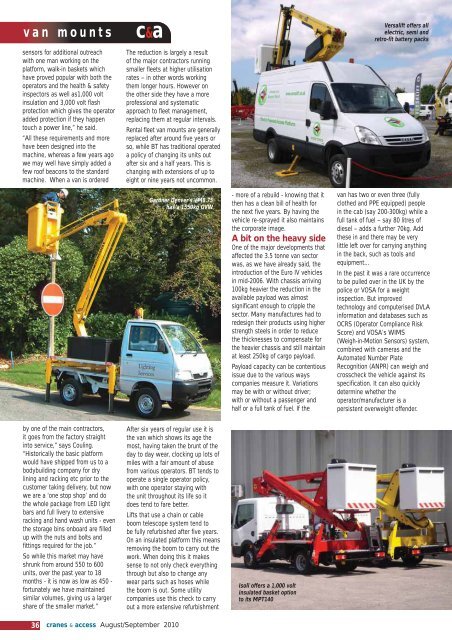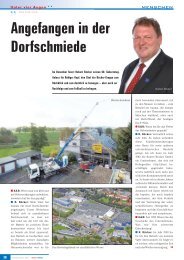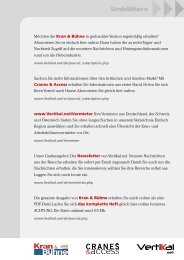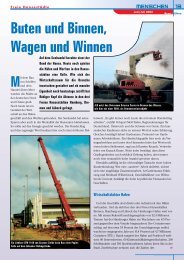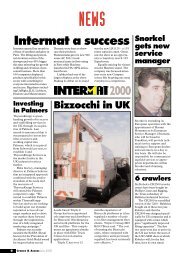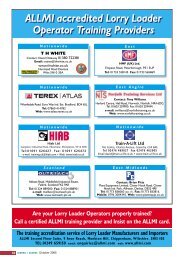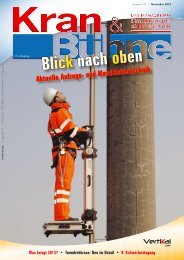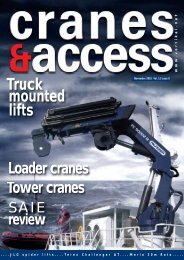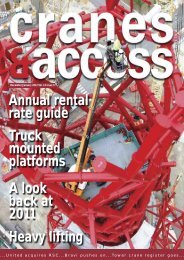Crawler - Vertikal.net
Crawler - Vertikal.net
Crawler - Vertikal.net
Create successful ePaper yourself
Turn your PDF publications into a flip-book with our unique Google optimized e-Paper software.
van mounts c&a<br />
sensors for additional outreach<br />
with one man working on the<br />
platform, walk-in baskets which<br />
have proved popular with both the<br />
operators and the health & safety<br />
inspectors as well as1,000 volt<br />
insulation and 3,000 volt flash<br />
protection which gives the operator<br />
added protection if they happen<br />
touch a power line,” he said.<br />
“All these requirements and more<br />
have been designed into the<br />
machine, whereas a few years ago<br />
we may well have simply added a<br />
few roof beacons to the standard<br />
machine. When a van is ordered<br />
by one of the main contractors,<br />
it goes from the factory straight<br />
into service,” says Couling.<br />
“Historically the basic platform<br />
would have shipped from us to a<br />
bodybuilding company for dry<br />
lining and racking etc prior to the<br />
customer taking delivery, but now<br />
we are a ‘one stop shop’ and do<br />
the whole package from LED light<br />
bars and full livery to extensive<br />
racking and hand wash units - even<br />
the storage bins onboard are filled<br />
up with the nuts and bolts and<br />
fittings required for the job.”<br />
So while this market may have<br />
shrunk from around 550 to 600<br />
units, over the past year to 18<br />
months - it is now as low as 450 -<br />
fortunately we have maintained<br />
similar volumes, giving us a larger<br />
share of the smaller market.”<br />
The reduction is largely a result<br />
of the major contractors running<br />
smaller fleets at higher utilisation<br />
rates – in other words working<br />
them longer hours. However on<br />
the other side they have a more<br />
professional and systematic<br />
approach to fleet management,<br />
replacing them at regular intervals.<br />
Rental fleet van mounts are generally<br />
replaced after around five years or<br />
so, while BT has traditional operated<br />
a policy of changing its units out<br />
after six and a half years. This is<br />
changing with extensions of up to<br />
eight or nine years not uncommon.<br />
After six years of regular use it is<br />
the van which shows its age the<br />
most, having taken the brunt of the<br />
day to day wear, clocking up lots of<br />
miles with a fair amount of abuse<br />
from various operators. BT tends to<br />
operate a single operator policy,<br />
with one operator staying with<br />
the unit throughout its life so it<br />
does tend to fare better.<br />
Lifts that use a chain or cable<br />
boom telescope system tend to<br />
be fully refurbished after five years.<br />
On an insulated platform this means<br />
removing the boom to carry out the<br />
work. When doing this it makes<br />
sense to not only check everything<br />
through but also to change any<br />
wear parts such as hoses while<br />
the boom is out. Some utility<br />
companies use this check to carry<br />
out a more extensive refurbishment<br />
36 cranes & access August/September 2010<br />
Gardner Denver’s VM8.75<br />
has a 1550kg GVW<br />
- more of a rebuild - knowing that it<br />
then has a clean bill of health for<br />
the next five years. By having the<br />
vehicle re-sprayed it also maintains<br />
the corporate image.<br />
A bit on the heavy side<br />
One of the major developments that<br />
affected the 3.5 tonne van sector<br />
was, as we have already said, the<br />
introduction of the Euro IV vehicles<br />
in mid-2006. With chassis arriving<br />
100kg heavier the reduction in the<br />
available payload was almost<br />
significant enough to cripple the<br />
sector. Many manufactures had to<br />
redesign their products using higher<br />
strength steels in order to reduce<br />
the thicknesses to compensate for<br />
the heavier chassis and still maintain<br />
at least 250kg of cargo payload.<br />
Payload capacity can be contentious<br />
issue due to the various ways<br />
companies measure it. Variations<br />
may be with or without driver;<br />
with or without a passenger and<br />
half or a full tank of fuel. If the<br />
Isoli offers a 1,000 volt<br />
insulated basket option<br />
to its MPT140<br />
Versalift offers all<br />
electric, semi and<br />
retro-fit battery packs<br />
van has two or even three (fully<br />
clothed and PPE equipped) people<br />
in the cab (say 200-300kg) while a<br />
full tank of fuel – say 80 litres of<br />
diesel – adds a further 70kg. Add<br />
these in and there may be very<br />
little left over for carrying anything<br />
in the back, such as tools and<br />
equipment...<br />
In the past it was a rare occurrence<br />
to be pulled over in the UK by the<br />
police or VOSA for a weight<br />
inspection. But improved<br />
technology and computerised DVLA<br />
information and databases such as<br />
OCRS (Operator Compliance Risk<br />
Score) and VOSA’s WIMS<br />
(Weigh-in-Motion Sensors) system,<br />
combined with cameras and the<br />
Automated Number Plate<br />
Recognition (ANPR) can weigh and<br />
crosscheck the vehicle against its<br />
specification. It can also quickly<br />
determine whether the<br />
operator/manufacturer is a<br />
persistent overweight offender.


